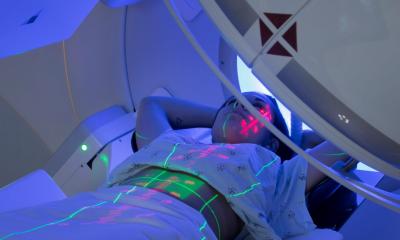News • Ten-year trial results
Radiotherapy reduces recurrence of early, hormone-driven breast cancer
Women with early, low risk, hormone-driven breast cancer are less likely to have a recurrence of their disease if they have radiotherapy after surgery, as well as anti-hormone treatment, according to results from a trial that has followed 869 women for ten years.
New findings from the 8 A trial of the Austrian Breast and Colorectal Cancer Study Group (ABCSG), presented at the ESTRO 38 conference, show that cancer did not return in the same breast in 97.5% of women who had whole breast irradiation (WBI), and in 92.4% of women who did not have WBI. After an average median follow-up of nearly ten years, there were ten recurrences of cancer in the same breast (in-breast recurrences) among the 439 women who had WBI and 31 among the 430 women who only had anti-hormone treatment. When the researchers looked at how long women survived without their disease recurring, there was a significantly higher disease-free survival rate of 94.5% among those who had WBI, compared to 88.4% among those who did not.

The cost, logistics and possible adverse side effects associated with WBI have led researchers to try to identify a subgroup of breast cancer patients who might not need radiotherapy. However, these latest results suggest this might not be possible. Associate Professor Dr Gerd Fastner, from the University Clinic of Radiotherapy and Radio-Oncology, University Hospital, Paracelsus Medical University in Salzburg, Austria, told the conference: “Our findings show that radiotherapy is still highly effective in significantly improving local control and disease-free survival in combination with anti-hormones, compared to anti-hormones alone. This remains true after long-term follow-up of breast cancer patients with a good prognosis. In our analysis the omission of whole breast irradiation turned out to be the main predictor for in-breast recurrences. In addition, tumours that could not have their grade classified, had a nearly four-fold risk of recurring, which might be due to some of the tumours being more aggressive.”
The ABCSG 8A trial, recruited 869 postmenopausal women between 1996 and 2004, and randomised them to receive either WBI or anti-hormone treatment alone after breast conserving surgery. The patients had early, low-risk tumours that were either grade 1 or 2, less than 3 cm in diameter and without any cancer cells identified in the lymph nodes. The tumours were driven by hormones such as oestrogen or progesterone and so would respond to anti-hormone therapies such as tamoxifen or anastrozole. The patients had received no previous chemotherapy, radiotherapy or hormone therapy. WBI was given up to a total average dose of 50 Gy over a period of 39 days and within six weeks of surgery; 71% of patients also received an additional boost of an average of 10 Gy to the tumour bed.
If cancer had spread to the first (sentinel) lymph node under the arm, then the sentinel node would also be removed during surgery, together with axillary lymph nodes. In cases where no tumour cells were found in the sentinel lymph node, removal of additional axillary nodes was omitted.
The researchers found that in the 258 women who had only the sentinel nodes removed, there was a 75% lower risk of disease recurring if they had WBI than if they did not. However, the same advantage in disease-free survival was not seen for WBI after the axillary nodes were removed. Overall survival and surviving without cancer spreading to other parts of the body (metastases) were similar between women who did or did not have WBI. “Improving control of the tumour at the primary site may translate into better survival in future years,” said Dr Fastner.
Recommended article

News • Cancer research
Black nanoparticles slow tumor growth
Melanin protects our skin from the sun’s damaging rays by absorbing light energy and converting it to heat. This could make it a very effective tool in tumor diagnosis and treatment, as demonstrated by a team from the Technical University of Munich (TUM) and Helmholtz Zentrum München. The scientists managed to create melanin-loaded cell membrane derived nanoparticles, which improved tumor…
Radiation treatments have progressed significantly since 2006 and now there are also other ways of delivering radiotherapy to the breast that are less toxic and time-consuming compared to whole breast irradiation
Umberto Ricardi
A later analysis of tissue from 519 of the patients, which looked at levels of a protein called Ki-67 (an indicator of cell proliferation) and another protein, HER2 (a growth promoting protein found on the outside of breast cancer cells), found that patients who had high levels of Ki-67 (above 20%) or who were HER2 positive, or both, did not have a higher risk of the cancer returning to the same breast, although there was a clear trend towards it. “This finding requires further research in larger groups of women with longer follow-up as this could be a chance finding because of the small numbers of women for whom we had this information,” said Dr Fastner. He concluded: “We believe that the additional benefits of postoperative radiotherapy have been confirmed in hormone receptor positive patients, regardless of whether or not they are at high risk of breast cancer recurrence. In the light of current knowledge, this does not necessarily mean that they have to have whole breast irradiation nowadays, since partial breast irradiation has proved to be competitive. Partial breast irradiation can be carried out with postoperative hypofractionated external beam radiotherapy [EBRT], intraoperative techniques or perioperative brachytherapy. The total omission of radiotherapy should only be considered in frail, elderly patients who would not be able to tolerate such treatment.”
President of ESTRO, Professor Umberto Ricardi, head of the Department of Oncology at the University of Turin, Italy, said: “In 2006 these researchers reported results from nearly five years of follow-up for these women, which showed that radiotherapy after surgery, combined with treatment with tamoxifen or anastrazole, resulted in a significant reduction in the risk of the cancer returning. These new results, with ten years of follow-up, show that the beneficial effects of irradiation persist, becoming even more evident, for these women. This is important information for women and their doctors, which helps them to choose the best treatment for their breast cancer. Radiation treatments have progressed significantly since 2006 and now there are also other ways of delivering radiotherapy to the breast that are less toxic and time-consuming compared to whole breast irradiation. This study also emphasises the benefits of long-term follow-up for women and the medical community.”
Source: ESTRO
26.04.2019











